Supply Chain Management Policy Implementation Strengths and Weaknesses Assessment at a Selected Higher Institution in the Eastern Cape Province South Africa
Introduction
Supply chain management (SCM) is critical in any institution’s delivery of goods and services since it involves the transportation and warehousing of supplies, work-in-process items, and final goods inventory to the end consumer (Bongsug, 2009). Without effective SCM systems, organizations are destined to collapse (Alcacer, and Oxley, 2012). According to Adendorff (2017), supply chain management comprises the integration and control of the system required to make items accessible in a prompt, replicable, and satisfying (i.e. meeting client needs) manner. According to Nkwanyana and Agbenyegah (2020), when the government sector implemented SCM changes, the key features were implemented as a method of operating inside the new regime. These comprise demand management, acquisition management, logistic management, and performance and risk management procedures. They are claimed to be methods for separating responsibilities, assuring supervision functions in the system, and therefore reducing risks.
According to Gomez (2019), the strength of SCM is to help organizations to take smarter decisions, choose the ideal allies, foresee and respond to marketplace and customer shifts, and avoid disruptions as well as boost operational efficiency. Thus, partnering alongside dependable providers, for instance, not only results in fewer interruptions and happier consumers but increases financial position by helping the organization to audit (and receive reimbursed over) items sooner. Balanced financial circulation may be achieved using better cost-effective ways to decrease excessive spending and reduce overhead expenses. Supply chain management aimed at endorsing cohesiveness in the activities pertaining to the reauthorization of bid board regulations
in the assorted organs of the state and delegating obligation and oversight for procurement-related operations to accounting officials or authorities. Substituting old public procurement and availability processes with integrated supply chain components and a structured competitive method for the nomination of specialists is an essential part of state financial management which adheres to globally recognized best practice principles.
The challenges identified with the application of the current Supply Chain Management (SCM) policy at Walter Sisulu University. Impairment of assets is not adequately performed by Walter Sisulu University; in accordance with the requirements of the Higher Education Act, 1997, and International Accounting Standards (IAS)36. Non-hiring of an Independent Valuator to determine the value in use of assets before disposal. Alignment of WSU Asset Management Policy with the National Road Traffic Act 93 of 1996 section 42 (1) in relation to the roadworthiness of motor vehicles. The research will provide effective and efficient policies that will lead to achieving the annual performance plan which is aligned with WSU’s strategic plan (2020-2030). This study is vital to the University management as it will guide during the review of the WSU Strategic Plan and create awareness of the problems that exist in place and product strategy to resolve the existing deficiencies caused by the Supply Chain Management policy. The research's goal is to examine the strengths and weaknesses that Walter Sisulu University has encountered in applying the supply chain management policy.
Methodology
Study area
Walter Sisulu University (WSU) is an institution of higher learning comply with the Higher Education Act 101 of 1997, as modified. The restructuring of the country’s higher learning commenced in 2002 and became finalized in 2005. This university offers a wealth of academic choices such as the Faculty of Commerce and Administration, Faculty of Educational Sciences, Faculty of Health Sciences, Faculty of Humanities, Social Sciences and Law, and Faculty of Natural Sciences. This university is located within the region of Eastern Cape under OR Tambo Local Municipality. The Walter Sisulu University has four Campuses with a total number of 33769 students and the Mthatha campus was chosen because it is the largest campus with 15407 registered students also Mthatha campus is the custodian of a large portion of WSU’s total Assets Walter Sisulu University (WSU) was founded on July 1, 2005, by combining the previous line of control Technikon, Eastern Cape Technikon, with University of Transkei.
Study method
A qualitative analysis approach was used in this analysis. Because the study emphasis area of Walter Sisulu University is fresh, this technique was judged appropriate. There was no proof that any study had previously addressed the exact audience. Another rationale for using this approach was to take cognizance of challenges and opportunities through implementing the Supply Chain Management Policy at the chosen university (Babbie, Mouton, Voster, and Prozesky, 2012), as the subject is sensitive and requires significant information. Qualitative research also provides a context for social action reasoning, which influences universities while the supply chain management and asset management are utilized as social action instruments in South Africa (Eriksson and Kovalainen, 2011).
Population and Sampling
Therefore, due to time, accessibility, plus financial restrictions, that's not always achievable. As a result, from the whole populace, a limited sample size (subset) is drawn. Walter Sisulu University has Four hundred and Forty (440) support workers and Five hundred Eight (508) academic personnel. This research’s sample included a maximum of 100, comprised of support and academic personnel individuals. Purposive or criteria sampling was employed to choose a sampling of university respondents for this investigation. Criterion sampling is comparable to judgmental or purposeful sampling. As this research intended to give choice to support and academic staff actively engaged in the execution of supply chain management and asset management policies, as well as thereby retain deep knowledge pertaining to any potential obstacles surrounding the subject matter, an attribute purposive sampling was used.
Data collection methods
During scientific data, two types of information-gathering procedures are commonly utilized (Saunders, Lewis, and Thornhill 2015). These would be the ways for collecting primary and secondary information. Primary information is gathered via interviews and observations, whereas secondary information is retrieved from previously published sources like textbooks, conference papers, journal articles, newspapers, reports, theses and dissertations, government documents, and organization websites (Flick, 2014). The primary and secondary pieces of information used to support the research premise are mostly primary and secondary materials. The type of data found in this experiment includes supply chain management along with personal information about the participants, such as gender, age group, race, profession, rank, and educational level.
Such research used both primary and secondary information references to assess the extent to which Walter Sisulu University faces challenges and opportunities in implementing the supply chain management policy as advised in the practical terms for the qualitative approach. Face-to-face/virtual interviews plus personal notes were used to obtain primary data. Furthermore, the university’s policy documents were examined. Extensive literature research was used as a secondary publication. These data-gathering methods were adopted to adhere to Doody and Noonan's (2013) case data-gathering criteria, which are: (i) utilizing various pieces of evidence; (ii) building a research database; and (iii) preserving a trail of evidence.
The interview queries were open-ended in order to enable participants to explain their perspectives. The interviews took between 20 and 30 minutes and had been conducted at a suitable time for the respondents. With the respondents’ agreement, they were audio and digitally taped and translated. The interviews were performed face-to-face also digitally within the usual environment of the support and academic personnel. Because the material relevant to this research was delicate, it was important to retain a feeling of understanding of respondents’ discomfort related to sensitive problems and encounters. As a result, participants were provided with a reflection when necessary, either shortly following the interviews or at a time suitable to them.
Data analysis
The study made use of the content analysis method to interpret and analyze the data collected. This approach may be defined as a research procedure for the logical, methodical, and quantitative assessment of communication’s apparent contents (Uwe, 2019). Therefore, in this study, content analysis constitutes much beyond a collecting procedure as it related to the findings with their situation or the area wherein, they were generated. Meaning, through content analysis, the study was able to draw accurate conclusions from verbal, graphical, or textual details in order to define certain occurrences.
Results and Data presentation
Results
The results of this academic evidence are typically composed of thematic analysis, as well as the actual words of the respondents. Some quantitative tools were used to present nominal data even though the study was qualitative. The researcher aimed to obtain a total of 100 interview responses but because of time limitations, only 40 interviews were successfully obtained for the study. These comprised twenty-two (22) support staff and eighteen (18) academic staff. Information was gathered through interviews. The goal in performing interviews has been to gain knowledge of the Support Staff and Academic Staff’s perspectives on the factors of importance in the topic.
Gender specification
The results shown in Figure 1 represent both the academic staff and support staff participants. The study was made up of women (60%) and men (40%). Of the women, ten (10) represented the support staff while fourteen (14) were of academics. While in males twelve (12) were from support and four (4) were from the academic staff. From these figures, one may see that women were more interested in being part of the study, unlike men participants.
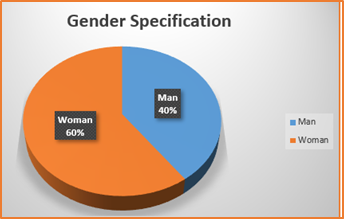
Age-group
The majority of the participants shown in Figure 2 represent an age group from 40-49 (15) followed by 30-39 (10). While the least age group was that of 6- Above (1). It can be depicted that the personnel from the academic and support areas are mostly dominated by those between the age of 40-49 years in WSU.
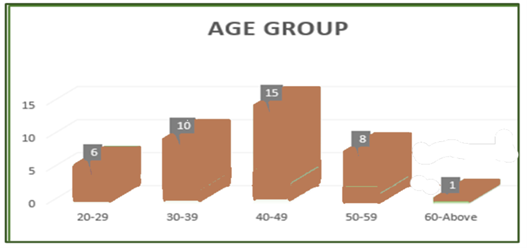
Level of qualification
The level of qualification is shown in Figure 3 of 40 participants, only one individual holds a certificate and is within the Support Staff group having over 15 years of working experience at WSU, and falls under the age group of 50-59 years. While the Diploma holders are 2 individuals within the Academic Staff with 10-15 years of experience and are between the 40-49 years of group age. Those with Undergraduate Degrees (10) are scattered across both the Support Staff and Academic Staff. Only three individuals hold an Honours/BTech qualification from the Support Staff (8), while only two individuals possess a Masters in the Support Staff group from the 12 in the diagram. They are only two Ph.D./Doctorate holders within the Support Staff out of the seven in the diagram.
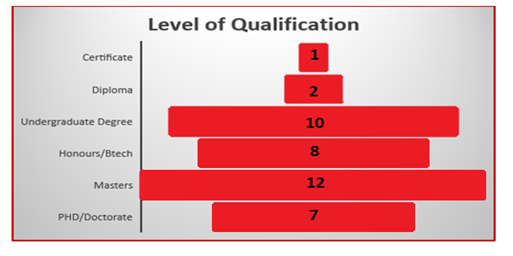
Period of service at Walter Sisulu University
As shown in Figure 4 eleven (11) participants have been working at the WSU institution for 1-5 years. While those that have 10-15 over 15 years have been working in the institution are ten (10). And the staff that has been serving WSU for 5-10 years are eight (8) and 0-1 year is merely one (1). These results are of good advantage to the study as most of the participants have the knowledge and vast experience in the areas of expertise in Supply Chain Management and Asset Management and therefore gave rich information and were able to fully answer the research questions.
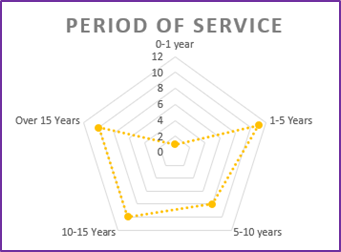
Perspectives and insights onto the Supply Chain Management Policy
Ways to enhance transparency and accountability to supply chain-related activities
The academic staff indicated that the institution needs to give ongoing stakeholder engagements for communication/updates and consult with the stakeholders whenever there is spending that will take place as shown in Figure 5. The institution needs to continuously do auditing and reporting to detect any possible hurdles that may pose a threat to the supply chain operations. The institution also needs to educate the staff about the budget and the existing SCM process for familiarity and there needs to be a creation of an SCM council where every department will have a representation onto. The support staff respondents indicated that WSU needs to have an online function that will allow for the budget to be reviewed along with the supplier database. The need to be regular SCM policy awareness training/workshops and ongoing communication and amendments thereto such policy.
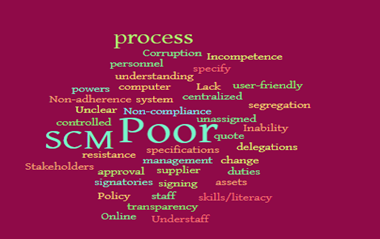
The institution also needs to have ongoing training about the roles; processes and procedures (to avoid duplication of duties). The SCM activities need to have a function that allows users to track bids/Requests for Proposal (RFP) used to open requests for bids to complete a new project proposed by the company or other organization that issues it. It is meant to open up competition and to encourage a variety of alternative proposals that might be considered by the project's planners; Request for Quote (RFQ) used is sent when you know exactly what product/service you want, and you only need to know the price. These findings agree with one of the five pillars of the Public Finance Management Act (PFMA) (Act No. 1 of 1999), particularly pillar 4 which covers accountability and reporting as persons and organizations are found liable for their intentions, activities, and results, and are obligated to greater transparency in governance as a result of external examination via reporting requirements.
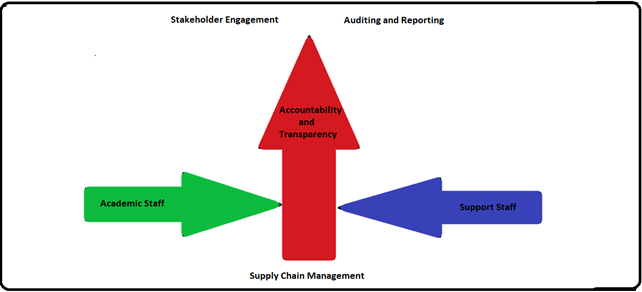
Possible effective programs to enhance adherence to Supply Chain Management Policy
Twenty-five percent (25%) of the respondents indicated that to enhance adherence to SCM, WSU needs to keep up with institutional websites/helpdesks that are accessible to everyone, while others (22%) stated that there need to be stakeholder engagements along with training, workshops, seminars and presentations as shown in Figure 6. Some (13%) suggested that WSU needs to make use of Finance Indaba by making policy awareness, while (10%) mentioned that the need to be a handover/distribution of handouts/fliers/notice board posts that serve as a reminder of what is expected of staff in terms of adherence to these policies. Few (5%) respondents mentioned that there needs to be employee appraisal incentives that will help to motivate others in being compliant in following policy guidelines and lastly, (3%) indicated that WSU needs to have strict punishment of perpetrators that misused/bypass these policies.
These results relate to National Treasury 2015; Parliamentary Monitoring Group (2013), which encourages the creation and execution of effective SCM procedures and internal standards. As SCM is put in place in a reasonable, equitable, open, innovative, and cost-effective manner as a result of this procedure. Furthermore, State universities may succeed in their adherence to legislation, reducing the risk of fraud, malfeasance, and favoritism, as also unjustified and irregular activities, in these universities. While Gopalakrishnan (2015) pointed out that adequate Risk Management in the SCM system ensures the core premise of the quality system that aims to develop a framework that governs the functional state of the institution’s resources while ensuring no danger is associated. Lastly, there needs to be an easily adaptable risk matrix that includes adherence to current policies; training of staff members to ‘Fit for Purpose’; and proper communication with relevant stakeholders about the importance of adherence to policy to mitigate possible risks.
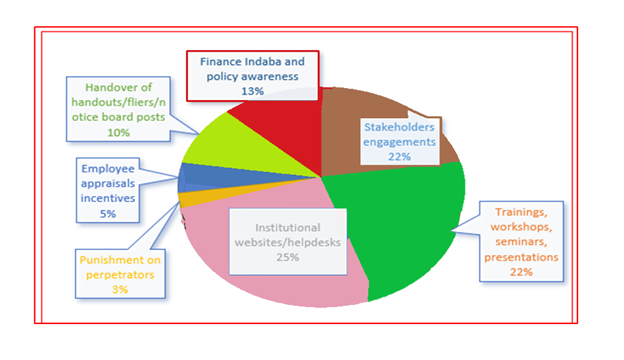
Challenges faced by WSU in the full implementation of SCM policy to all WSU transactions
As much as WSU has its own SCM Policy that serves as a guideline across its supply chain-related activities, it also encounters challenges towards the implementation of the document as shown in Figure 7. Therefore, the respondents indicated that the still exists non-compliance, non-adherence, and incompetence among the staff when implementing what is in the policy and these easily lead to corrupt acts as others use their roles to bypass and overrule decisions. Others mentioned that the processes of the SCM are not user-friendly and staff lacks understanding of how they operate in areas such as quoting, specification, and the signatories/approval of stages and thus makes them resistant to the online system and resulting in understaffed personnel in the usage of the online system. The respondents also mentioned that centralizing the SCM makes it time-consuming. The policy is unclear with regards to specific assigned and segregation of duties as well as powers resulting in the SCM being regarded as poor by relevant stakeholders as there is an issue of supplier management and the management of assets. And no easily adaptable risk matrix includes adherence to current policies; training of staff members to ‘Fit for Purpose’; risk-based asset management activities to Identify challenges and critical issues staff is encountering; and using proper communication with relevant stakeholders about the importance of adherence to policy (Gopalakrishnan (2015).
Moreover, this contradicts the Preferential Procurement Policy Framework Act (2000) that stipulates for every government university adhere to supplementary legislation controlling the South African structure. Institutions must admit to a misunderstanding on how to apply SCM techniques. This is when senior management possesses no sense of trust to engage stakeholders, and important strategic initiatives are not driven as effectively as they could be (Dlamini and Ambe, 2013). This may be attributed to the institution’s top effective governance structures having an insufficient understanding of SCM, as well as the fact that no attempt is done to teach players the importance of SCM towards the university. This situation equates to a lack of effective SCM expertise throughout the institution. SCM, for instance, has become a frequently misunderstood phrase within South Africa (Ruzic-Dimitrijevic 2014).
Conclusion
The study revealed that both the literature and empirical results highlighted that having an SCM policy in place provides for statutory guidance in the existing system, that encourages institutions to play a role of being open, transparent, and cost-saving by any means. Thus, entails that the presence of an SCM policy serves as a foundation of an official’s ethical behavior as it stipulates how they are expected to behave. Because of this, an SCM system ends up minimizing the fallout of human errors and makes it possible for the documents to be accessible anywhere as it monitors and evaluates the activities taking place. The findings showed that, when the SCM policy is not specific and complex toward the understanding of its users, it becomes difficult for the SCM activities to be effectively implemented in accordance with the prescribed policy. The complexity and ambiguity of the policy also invite the implementation of the SCM to restrict innovation from the users in terms of having adequate awareness and drive to be technologically advanced to keep up with the changing ways of doing things. It can be concluded that the existence of the SCM Policy serves and plays an integral part in controlling, managing, and monitoring the institutional resources of the institution. The presence of the policy makes the operations much easier when the relevant stakeholders play their respective roles of unity in ensuring that the objectives of the SCM are met expectedly. But once the policy is complex and the implementors find it difficult to understand and apply it in their operations, then this hinders the institutional resources as well as the image of the department with its officials.
References
Ambe, I. M., & Badenhorst-Weiss, J. A. (2012). Supply chain management challenges in the South African public sector. African Journal of Business Management, 6(44), 11003-11014.
Babbie, E., & Mouton, J. (2001). The practice of social research: South African edition. Cape Town: Oxford University Press Southern Africa.
Burt, D., Petcavage, S. and Pinkerton, R. (2010). Supply management. McGraw-Hill, New York.
Dlamini, W., & Ambe, I. M. (2012). The influence of public procurement policies on the implementation of procurement best practices in South African universities. Journal of Transport and Supply Chain Management, 6(1), 277-293.
Doody, O., & Noonan, M. (2013). Preparing and conducting interviews to collect data. Nurse Researcher, 20(5).
Eriksson, P., & Kovalainen, A. (2015). Qualitative methods in business research: A practical guide to social research. Sage.
Flick, U. (2014).The SAGE handbook of qualitative data analysis. [Online] Available at: http://www.sagepub.com/upm-data/588969_Flick_TheSAGE_HB_of_ Qualitative_Data_Analysis.pdf [Accessed on 27 September 2021].
Gomez, J. (2019). The key benefits of effective supply chain management. [Online] Available from: https://6river.com/8-key-benefits-of-effective-supply-chain-management/[Accessed on 30 July 2021].
Gopalakrishnan, G. (2015). How to apply academic supply chain management: The case of an international university. Management: journal of contemporary management issues, 20(1), 207-221.
Hassan, S., Ramli, S. H., Roslan, R. and Jaafar, J. (2015). Supplier performance management at higher education institutes. Procedia Economics and Finance, Vol. 31, pp: 671-676.
Institution for the supply chain management. (2014). [Online] Available from: http://www.ioscm.com [Accessed on 27 April 2022].
International Organization for Standardization (ISO). (2014). Asset Management: Overview, principles, and terminology. Standard Norge: International Standardization Organization.
National Treasury. (2015): Public sector supply chain management review. [Online] Available from: http://www.treasury.gov.za [Accessed on 27 April 2022].
Open-Test. (2017). The Benefits of Supply Chain Management. [Online] Available from: https://blogs.opentext.com/benefits-supply-chain-management/ [Accessed on 23 July 2021].
Ruzic-Dimitrijevic, L. (2014). Risk assessment of knowledge management system. Online Journal of Applied Knowledge Management, 3(2), 114-126.
Woodhouse, J. (2010). 10 Asset management: the way forward. In Asset management Whole-life management of physical assets (pp. 201-221). Thomas Telford Ltd.
Author: Lonwabo Lukhanyo Vikilahle, student LIGS University
Approved by: Minh Nguyen, lecturer LIGS University